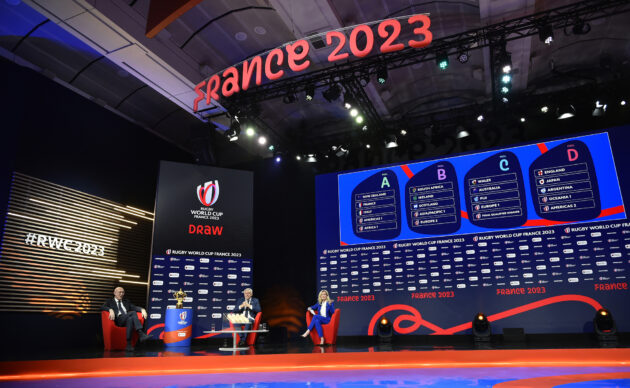Everything you need to know before the names come out of the metaphorical hat for the 2027 Men’s rugby World Cup
The Men’s Rugby World Cup 2027 draw will be an important moment for fans of every team that’s qualified for Australia.
A favourable pool could mean you spend the next two years feeling optimistic as your side builds up to the tournament. Wind up in a so-called “pool of death”, however, and those preparations could be accompanied by a side order of dread.
An expanded World Cup means a new format for the competition, a new seeding system, and more teams than ever making it through to the knockout stages. Read on to find out when the 2027 Men’s Rugby World Cup draw takes place, how the new tournament structure will work, and where your team is likely to be seeded.
When does the Men’s Rugby World Cup 2027 draw take place?
The 24 competing teams will learn who they’ll be playing – and start planning out their itineraries – when the draw takes place in Sydney, Australia on Wednesday 3 December 2025. This means that the upcoming November internationals are even more important than usual, with world rankings at the start of December determining the seedings for the World Cup draw. It will also be the first time every qualifier has been confirmed before the draw takes place.
You’ll be able to watch the draw as it happens on World Rugby’s RugbyPass TV, and selected broadcasters around the world – including Channel Nine in Australia.
24 competing teams? Aren’t there usually 20?
Yes, the previous seven World Cups have featured 20 teams but the 2027 edition has expanded the field to include 24. That also requires a change of format.
Whereas the old 20-team system featured four pools of five teams, the Men’s Rugby World Cup 2027 will have six pools of four teams – just like football’s European Championship.
In the new-look competition, 16 teams will make it through the pool stages, rather than the eight who survived in the original format. This necessitates an additional round of 16.
The route to the William Webb Ellis Cup will now look like this:
- 3 pool matches
- Round of 16 match
- Quarter-final
- Semi-final
- Final
Although there’s a whole extra round of matches, the two teams that reach the final will still feature in seven matches. This is because each team will play one game fewer in the pool stages.
But while the total number of matches in the tournament increases from 48 to 52, the duration of the tournament will actually decrease. This is because there’s no longer any need for teams to have a “fallow” week during the pool stages, an inevitable consequence of five-team pools. So, even with the mandatory minimum of five rest days between games, this World Cup will be a whole week shorter than its predecessor at just 43 days.

The Men’s Rugby World Cup draw for France 2023 had fewer teams to manage (Aurelien Meunier – World Rugby/World Rugby via Getty Images)
What do teams need to do to qualify for the round of 16?
This change makes the competition less elegant than the old format, in which the top two teams from each pool made it through to the knockouts.
Although the pool winners and runners-up will still qualify for the round of 16 automatically, there’s now room for four more places in the knockout stages. These will be filled by the four best third-placed teams, determined by (in this order) competition points, points difference and try difference.
The result is a rather less efficient way of eliminating teams, seeing as 36 games will be played in order to send just eight teams home (a third of the field), compared to the 40 matches that removed 12 sides (three fifths of the sides) in the old days.
This also means less pool game jeopardy for the leading teams, which may make the early stages of the competition less exciting.
How is the draw organised?
Each of the 24 teams will be seeded according to their ranking when the Rugby World Cup draw 2027 takes place in December. They’ll then be sorted into four bands of six teams based on those seedings.
Each pool will include a team from each of the four bands. Based on current world rankings, the four bands would look like this:
Band 1 (based on current standings)
South Africa, New Zealand, Ireland, France, England, Argentina
Band 2
Australia, Scotland, Fiji, Italy, Georgia, Wales
Band 3
Japan, Spain, USA, Chile, Tonga, Uruguay
Band 4
Portugal, Romania, Hong Kong China, Canada, Zimbabwe, Unconfirmed final qualifier*
*Belgium, Namibia, Samoa or Paraguay are competing for the final World Cup place in a tournament in Dubai in November. If Samoa secure the win, their current world ranking (16th) would place them in Band 3.
Does it matter which pool your team is drawn in?
The introduction of third-placed qualifiers does create an intriguing irregularity. While the winners of Pools A, B, C and D will play their round of 16 matches against third-placed teams, the winners of Pools E and F will face the runners-up of Pools D and B, respectively – in theory, easier ties.
World Rugby claims that the imbalance will be addressed in the quarter-finals, with – for example – the winner of Pool E guaranteed a knockout game against another runner-up (from Pool C or Pool F) should they make it through the round of 16. In other words, they could avoid facing any pool winners en route to the semi-finals.
It would be interesting to see, however, how England or Argentina would feel about that if they topped Pool E, and subsequently found themselves plunged into a round of 16 tie against, for example, Scotland. It’s probably fair to assume they’d rather be playing Japan, Spain, USA, Chile, Tonga or Uruguay from Band 3…
Ahead of the draw, the only certainty is that host nation Australia will be in Pool A. If the Wallabies have a successful November and break into the top six of the world rankings, they’ll be joined by a team from Band 2. If they can’t climb above their current seventh place, they’ll have to contend with one of the Band 1 giants in Pool A.
Download the digital edition of Rugby World straight to your tablet or subscribe to the print edition to get the magazine delivered to your door.
Disclaimer : This story is auto aggregated by a computer programme and has not been created or edited by DOWNTHENEWS. Publisher: rugbyworld.com







